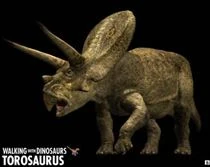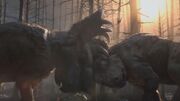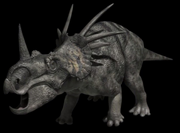Template:Dinoseries

Torosaurus
The ceratopsians, also known as the horned dinosaurs, were a group of omnivorous ornitischians or bird-hipped dinosaurs (as opposed to the lizard-hipped sauropodomorpha dinosaurs). They existed mainly during the late Cretaceous time period, in the Americas and also in Asia.
The ceratopsians are subdivided into two groups: the chamosaurines and the centrosaurines. Largely identical to each other - short but powerful legs, robust bodies, tortoise beak-like jaws and a varied number of horns - they had either a shorter, more plain frill with smaller openings that didn't extend beyond the dinosaur's neck and shoulders or a longer frill with larger internal openings that extended further beyond the shoulders, occassionally possessing spikes of various length on its end.
Besides the ceratopsids, there were also their smaller, more ancient cousins, the proceratopids. They differed from the ceratopsids by being much smaller in size and usually lacking any horns or frill ornaments. The colony of Protoceratops dinosaurs, featured in the second episode of Chased by Dinosaurs were typical members of the protoceratopid family.
Protoceratops. (Official image).
The last episode of Walking with Dinosaurs featured Torosaurs, members of the chamosaur family. They were featured fighting for females of their herd, like modern antelope do, and they were killed when the meteorite struck at the end of the episode.
This episode also featured a dead Triceratops, another triceratopsin chasmosaur, and one of the best known dinosaurs. Just like the Torosaurs and other non-avina dinosaurs, Triceratops died out by 65 MYA.
A sideview of Triceratops' skull. (Wikipedia image)
The WWD:3-D film featured Pachyrhinosaurus, a more distant cousin of Triceratops and Torosaurus. Unlike them, Pachyrhinosaurus didn't have any horns on its nose, but rather a thick boss of bone or keratin instead. It also had a forwards-jutting horn-like structure above its head. Pachyrhinosaurus behavior was probably similar to the other ceratopsians showed by Impossible Pictures (though perhaps more migratory) and like the other dinosaurs Pachyrhinosaurus died out by 65 MYA.

Dueling pachyrhinosaurs. (Shot from the film.)
Walking with Dinosaurs: Inside their World has introduced Styracosaurus and Pentaceratops. Styracosaurus was a relative of Pachyrhinosaurus, but it had a long nasal horn instead. Pentaceratops was more closely related to Triceratops instead. Both of them died out some time before the K/T extinction.

Styracosaurus.
In the Walking with...series
Walking with Dinosaurs
Death of a Dynasty
The Ceratopsid Torosaurus makes an appearance and is shown several times, most notably when it depicted its courtship behavior. The more famous Triceratops is shown in a cameo as the carcass the male Tyrannosaurus rex uses to court the female.
Chased by Dinosaurs
The Giant Claw
A herd of Protoceratops appears as an obstacle in Nigel's path because of their sharp beaks could parentally kill him. So he uses a red blanket to distract them.
Another is later seen being killed and eaten by a pack of Velociraptor.
Walking With Dinosaurs (film)
This movie is centered on a herd of Pachyrhinosaurus, and most importantly its main character, named Patchi. Despite the fact that WWD:3-D has many elements of an entertainment film rather than a documentary, it still depicts the lives of a Pachyrhinosaurus herd during the late Cretaceous period with some accuracy.
Appearances in other media
Prehistoric Park
Triceratops makes a comeback in this related media.
Trivia
It should be noted that Protoceratops isn't a Ceratopsid, but rather a Ceratopsian.
|
